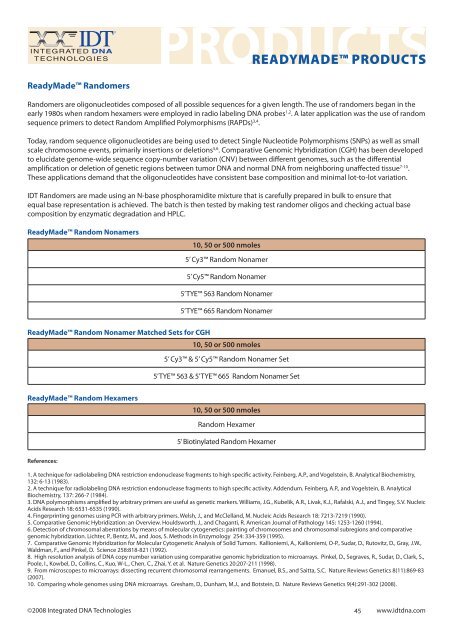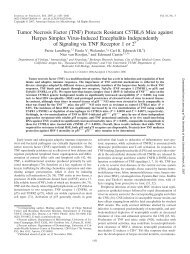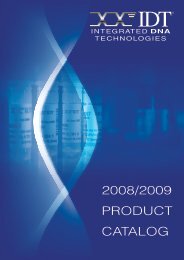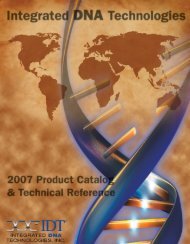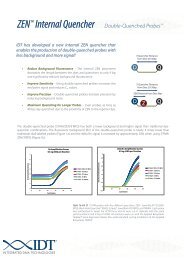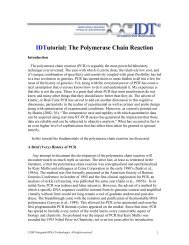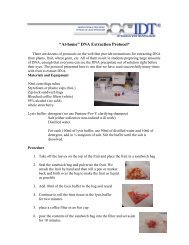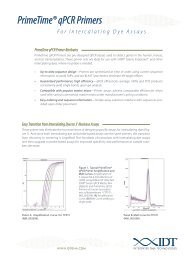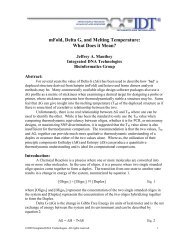products - Integrated DNA Technologies
products - Integrated DNA Technologies
products - Integrated DNA Technologies
Create successful ePaper yourself
Turn your PDF publications into a flip-book with our unique Google optimized e-Paper software.
INTEGRATED<strong>DNA</strong>TECHNOLOGIESREADYMADE PRODUCTSReadyMade RandomersRandomers are oligonucleotides composed of all possible sequences for a given length. The use of randomers began in theearly 1980s when random hexamers were employed in radio labeling <strong>DNA</strong> probes 1,2 . A later application was the use of randomsequence primers to detect Random Amplified Polymorphisms (RAPDs) 3,4 .Today, random sequence oligonucleotides are being used to detect Single Nucleotide Polymorphisms (SNPs) as well as smallscale chromosome events, primarily insertions or deletions 5,6 . Comparative Genomic Hybridization (CGH) has been developedto elucidate genome-wide sequence copy-number variation (CNV) between different genomes, such as the differentialamplification or deletion of genetic regions between tumor <strong>DNA</strong> and normal <strong>DNA</strong> from neighboring unaffected tissue 7-10 .These applications demand that the oligonucleotides have consistent base composition and minimal lot-to-lot variation.IDT Randomers are made using an N-base phosphoramidite mixture that is carefully prepared in bulk to ensure thatequal base representation is achieved. The batch is then tested by making test randomer oligos and checking actual basecomposition by enzymatic degradation and HPLC.ReadyMade Random Nonamers10, 50 or 500 nmoles5’ Cy3 Random Nonamer5’ Cy5 Random Nonamer5’ TYE 563 Random Nonamer5’ TYE 665 Random NonamerReadyMade Random Nonamer Matched Sets for CGH10, 50 or 500 nmoles5’ Cy3 & 5’ Cy5 Random Nonamer Set5’ TYE 563 & 5’ TYE 665 Random Nonamer SetReadyMade Random Hexamers10, 50 or 500 nmolesRandom Hexamer5’ Biotinylated Random HexamerReferences:1. A technique for radiolabeling <strong>DNA</strong> restriction endonuclease fragments to high specific activity. Feinberg, A.P., and Vogelstein, B. Analytical Biochemistry,132: 6-13 (1983).2. A technique for radiolabeling <strong>DNA</strong> restriction endonuclease fragments to high specific activity. Addendum. Feinberg, A.P., and Vogelstein, B. AnalyticalBiochemistry, 137: 266-7 (1984).3. <strong>DNA</strong> polymorphisms amplified by arbitrary primers are useful as genetic markers. Williams, J.G., Kubelik, A.R., Livak, K.J., Rafalski, A.J., and Tingey, S.V. NucleicAcids Research 18: 6531-6535 (1990).4. Fingerprinting genomes using PCR with arbitrary primers. Welsh, J., and McClelland, M. Nucleic Acids Research 18: 7213-7219 (1990).5. Comparative Genomic Hybridization: an Overview. Houldsworth, J., and Chaganti, R. American Journal of Pathology 145: 1253-1260 (1994).6. Detection of chromosomal aberrations by means of molecular cytogenetics: painting of chromosomes and chromosomal subregions and comparativegenomic hybridization. Lichter, P., Bentz, M., and Joos, S. Methods in Enzymology 254: 334-359 (1995).7. Comparative Genomic Hybridization for Molecular Cytogenetic Analysis of Solid Tumors. Kallioniemi, A., Kallioniemi, O-P., Sudar, D., Rutovitz, D., Gray, J.W.,Waldman, F., and Pinkel, D. Science 258:818-821 (1992).8. High resolution analysis of <strong>DNA</strong> copy number variation using comparative genomic hybridization to microarrays. Pinkel, D., Segraves, R., Sudar, D., Clark, S.,Poole, I., Kowbel, D., Collins, C., Kuo, W-L., Chen, C., Zhai, Y. et al. Nature Genetics 20:207-211 (1998).9. From microscopes to microarrays: dissecting recurrent chromosomal rearrangements. Emanuel, B.S., and Saitta, S.C. Nature Reviews Genetics 8(11):869-83(2007).10. Comparing whole genomes using <strong>DNA</strong> microarrays. Gresham, D., Dunham, M.J., and Botstein, D. Nature Reviews Genetics 9(4):291-302 (2008).©2008 <strong>Integrated</strong> <strong>DNA</strong> <strong>Technologies</strong> www.idtdna.com45


